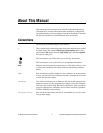
Chapter 1 Introduction
Automotive Diagnostic Command Set User Manual 1-6 ni.com
Note Some parameters to both the Request and Positive Response Messages are optional.
Each service defines these parameters. Also, the standard does not define all parameters.
The Negative Response Message is usually a three-byte message: it has the
Negative Response ServiceId (0x7F) as first byte, an echo of the original
ServiceId as second byte, and a ResponseCode as third byte. The UDS
standard partly defines the ResponseCodes, but there is room left for
manufacturer-specific extensions. For some of the ResponseCodes, UDS
defines an error handling procedure.
Because both positive and negative responses have an echo of the requested
service, you always can assign the responses to their corresponding request.
External References
For more information about the UDS Standard, refer to the ISO 15765-3
standard.
OBD (On-Board Diagnostic)
On-Board Diagnostic (OBD) systems are present in most cars and light
trucks on the road today. On-Board Diagnostics refer to the vehicle’s
self-diagnostic and reporting capability, which the vehicle owner or a
repair technician can use to query status information for various vehicle
subsystems.
The amount of diagnostic information available via OBD has increased
since the introduction of on-board vehicle computers in the early 1980s.
Modern OBD implementations use a CAN communication port to provide
real-time data and a standardized series of diagnostic trouble codes
(DTCs), which identify and remedy malfunctions within the vehicle. In the
1970s and early 1980s, manufacturers began using electronic means to
control engine functions and diagnose engine problems. This was primarily
to meet EPA emission standards. Through the years, on-board diagnostic
systems have become more sophisticated. OBD-II, a new standard
introduced in the mid 1990s, provides almost complete engine control and
also monitors parts of the chassis, body, and accessory devices, as well as
the car’s diagnostic control network.
The On-Board Diagnostic (OBD) standard defines a minimum set of
diagnostic information for passenger cars and light and medium-duty
trucks, which must be exchanged with any off-board test equipment.


















